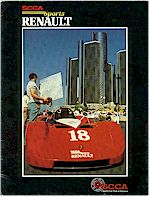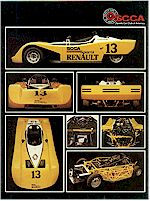|
July, 1985 SportsCar -
“Fastrack”:
“BOD Meeting 5/30/85: -- Competition Board Items Approved
2. Seat modifications are permitted to allow padding or fitting for comfort of the
driver. Foaming is permitted.
4. Radios are permitted provided they are securely attached to the chassis.
They may be wired into the fuse panel , provided the wiring is neat and serves no other
purpose.
5. Brake ducts for the front brakes will be required to relieve overheating.
7. An additional radiator baffle to block air flow between the top of the radiator
and body will be required.
8. A radiator screen of 1/4 inch wire mesh or hardware cloth must be installed to
protect the radiator from rock damage. The screen must be installed vertically from
the additional radiator baffle to the undertray and from side to side between the side
baffles at the bend.”
 

The cover and inside page of the orginal SR sales brochure.

July, 1985 SportsCar -
“Fastrack”:
“Clarification of New Sports Renault Rules
Accessory Items...Not Required
Seat modifications are permitted to allow padding for the comfort and safety of the
driver. Foaming is permitted. Additionally, the seat may be cut or slit to allow the
seat belt (five or six point) to cross the driver's body and remain in proper alignment
per the GCR. Any cuts in the seat should be reinforced to prevent splitting.
Headrest Pad may be reduced in thickness for drivers comfort.
Racer's Tape may be used to repair crash damage, or as a precautionary means of securing
the body retaining clips. Crash damage is defined as having occurred during the
current event, and the tape should be of an appropriate color. Tape cannot be used
to close up body seams.
Replaceable Skid Plates may be added to the rear corners of the frame to prevent grinding
off metal on rough courses.
Mandatory Items
Roll Bar Pads are required....material per the GCR.
Battery Post Covers are required....material per the GCR.”

August, 1985 SportsCar -
“Fastrack”:
“Sports Renault Technical Orders
10. Tonneau covers and their attaching hardware are
allowed.”

September, 1985 Car and Driver - “Long Deals on Hot
Wheels” by Rich Ceppos. Excerpts from the article above.
The Sports Renault story starts back in 1983, when both Renault and the SCCA were looking
for something. Renault USA wanted a new company-backed race series to add more
luster to the corporate image. The SCCA, for its part, was after a new brand of
low-buck racing: a one-design class in which the driver, not the car would make the
difference.
Renault/Jeep Sport pulled off what many thought impossible. Within a year after the
agreement with SCCA was struck, the ten-grand Sports Renault was unveiled. In June
of 1984, the first batch of cars was baptized on the Detroit Grand Prix street course.
Since then more than 240 Sports Renaults have been delivered, each and every one an
exact duplicate of the first.
The bottom line is what the racers think of all this, so we visited the second pro race of
the year, held at Sears Point International Raceway. The first problem was finding
someone to talk to. The corner of the paddock where the Sports Renaults were
gathered was virtually deserted. No one was working on the cars. Finally, we
came across racer Bob Merrill, kneeling behind his car, cleaning the muffler.
Competitor Dave Rice was looking on from a lawn chair.
“Bob felt like he ought to do something to his car,” said Rice with a chuckle,
“so I thought I'd come over and watch.” Rice's car was parked nearby.
No one was working on it, either.
The Sports Renault guys are a good bunch. After Saturday morning’s qualifying
session, they hang around and chat through the afternoon. The main topic of
conversation is what will happen to the winner of the first pro Sports Renault race, who
was caught loosening up his muffler for more power. For the most part, though, they
believe that no one is getting away with anything blatant.
Sunday’s race is a doozy. Pole sitter Ray Kong conks out on the first lap with
a bad rear-axle bearing. Mitch Wright, last year’s Renault Cup champion, comes
out of nowhere and starts running away with it. After an accident at the halfway
point - ten laps - the pack bunches up and Wright has to do it all over again. Back
in the pack there’s plenty of hard driving and body contact. Merrill
spins. Wyborny slips from second to fourth. On the last lap, Wright runs out
of fuel within sight of the checker flag and coasts across the line third.
All in all, it looks like a whale of a good time.

October, 1985 SportsCar -
“Fastrack”:
Sports Renault Decisions
Extensive time was spent discussing all facets of the Sports Renault program and several
significant decisions were made. Customer Service Representatives (CSRs) will now be
permitted to perform engine rebuilds, a service heretofore limited to Renault/Jeep Sport
(RJS). However, the CSR must have an RJS certified mechanic perform the work, it
must be done on the premises and no machining is allowed--only parts replacement.
A decision which will be popular among tall drivers was the authorization of the RJS roll
bar extension kit. This adds more height to the roll bar to adequately protect the
head of a taller driver. Individual owners are responsible for installing the kit,
and certified welding is recommended but not mandatory. This roll bar extension was
not a popular solution; the Board members recognized it is not consistent with the GCR
roll bar practice, and they would have preferred tall drivers replacing the entire roll
bar. But it was determined this was a very costly maneuver because of the way in
which the car is constructed. The extension was greed to only after the board was
assured the RJS design is tested and quite safe if properly installed.

1987 SCCA Pro Sports Renault Schedule
Pacific Division
Firebird International, Winner: Rick Anderson
Willow Springs, Winner:?
Sears Point, Winner:?
Riverside, Winner: Ray Wong
Midwest Division
St. Louis, Winner: ?
St. Louis, Winner: ?
Mid-Ohio, Winner:?
September 6: Memphis International, Winner: Gene Harrington
Atlantic Division
Summit Point, Winner, Gene Harrington
Lime Rock Park, Winner: David Murray
Detroit Grand Prix, Winner: Willie Lewis
Mosport, Winner: Willie Lewis
National Championship
Road Atlanta, Winner, Dorsey Schroeder

Miscellany from 1985
Dorsey Schroeder wins Lucas Pro Challenge
Scott Lagasse named Lucas Pro Challenge “Rookie of the Year”
Scott Lagasse wins 1985 Runoffs
Tom Dalrymple wins SWDiv with 50 points
Gene Harrington wins CenDiv with 69 points
155 Sports Renaults sold in calendar year 1985, total to date:306 |